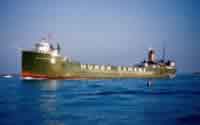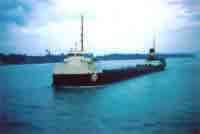Vessel Histories Definitions

A major Great Lakes vessel is defined as one which at some time during its Great Lakes service was measured at 1000 or more gross registered tons under the measurement rules of the flag country. A vessel is in Great Lakes service if it is in commercial service transporting cargo (including passengers) between ports on the Great Lakes or the St. Lawrence River above tidewater or between ports on the Great Lakes and ports on the lower St. Lawrence River. Excluded are vessels operating exclusively within a harbor; government, private use (yachts) and other non-commercial vessels; scows; dredges and tugs. Also excluded are vessels trading into but not on the Great Lakes (“salties”), even though they may happen to carry a cargo between two Great Lakes ports incidental to a voyage into the Lakes. These histories generally do not include details concerning the operations of vessels while in service off the Great Lakes, other than name changes and final disposition where known. They also do not include much detail about motive power (diameter of cylinders, length of stroke, boiler details, etc.), since I have little knowledge about this subject and therefore would have no way of judging the probable correctness of any data of this kind that I might find. (I was a deckhand during my college summers, not a coal passer!) Other researchers have most adequately covered this area.

The names of vessels, both while in Great Lakes and off-Lakes service, are shown in bold face type. Also in bold face type are the names of operating companies and vessel official numbers while the vessel is in Great Lakes service.
The years noted at the upper left and upper right corners of each history are the beginning and ending years the vessel was in Great Lakes service. A year in parentheses before the year in or after the year out are years operated in off-Lakes service before and/or after service on the Lakes, and in a few cases year built of a vessel built on the Great Lakes which did not enter service for a period after build.
Example: Cayuga was built in 1920 on speculation by the shipyard for hopeful sale for off-Lakes service. A buyer could not be found and she remained out of active service. She entered service on the Great Lakes in 1922 and operated on the Lakes for some years until her eventual sale off the Lakes. I have listed her as having entered service in 1922, with year 1920 in parentheses to indicate year built, and as having left in 1937, with year 1938 in parentheses to indicate year lost.
Vessel dimensions are from a number of sources. Where my files did not include length overall (LOA), I have frequently borrowed the figure, adjusted where appropriate for lengthenings and shortenings, listed in the Greenwood Namesakes series. Length between perpendiculars (LBP) and moulded breadth and depth have come from the Record of the American Bureau of Shipping unless that figure is clearly in error (and in most such cases these errors have been corrected by them in later editions). Registered dimensions and tonnages are from the vessel enrollments where available to me or from U. S. and Canadian official publications. American vessel registered dimensions through June 30, 1898 were published in tons and hundredths of a ton. Beginning July 1, 1898 the decimals were dropped (NOT rounded). (Until mid-1864 U. S. vessels were measured in feet and inches under very different measurement rules. Net tonnages were not published until 1882.)
A note about numbering vessels with the same name: Different researchers have different ways of keeping track of vessels with the same name. Some number all of them, including tugs. Others just number vessels in the same fleet. My system numbers my metal-hulled “major vessels” (including composite vessels) in the order they first carried that name in Great Lakes service. A name carried by a vessel exclusively in off-Lakes service is ignored. A separate numbering system is used for wooden vessels, which were renamed and duplicate-named much less frequently than metal vessels.

Sterling:
Looks like a great beginning. I’ll look forward to using it. Hope you had a good trip NORF. Dave
Looking for pictures of the Alastair Gutherie C.M.A.
I have a picture of my grandparents standing on the Abraham Stearn. On the back it states it was taken in the early 1900″s. It looks like just like the picture on your site. My grandparents were from Wisconsin and my father said he earned a living working the ships on the Great Lakes. Where can I find more information? I would appreciate your help.
Barbara Stainback
Late reply. Just found this.
You could post your question on the Information Search page of boatnerd.com. They have people there who have vessel manning records.
Thank you so very much!
where can I find photos of the Jesse H Farwell – built in Gibraltar, MI 1881
My uncle, Franklin Simonson, spent a career on great lakes frieghters retiring in the late 50s or early 60s. Is there any way that I could find out what ships he was serving on. I believe he retired a chief engineer and may have served on the arthur anderson, but that is a guess. May have also been with the pittsburg steam ship company.
david coven
Was there a ship called the S.S. Great Lakes?
Thank You
Very Much Mr Berry.
I was able to trace a picture of The William B Schiller with the help of your web site entering the port of Lorain Ohio. My Father operated iron ore un-loaders crane there at the river front. Finding the history about the W.B. Schiller as being also built by the American Ship Building ship yard there in Lorain very interesting.
For the information very good
Thank You
Louis Jacobs
we are looking for imformation on our father freighter the Collingwood onwed by c s l
I need a photo of the WWI Laker Class freighter deck showing the bulwark stanchions, or braces
I would suggest you submit your request on the Information Search section of boatnerd.com. I’m sure someone out there has what you are looking for.
I was a high school graduate and a deckhand on the SS TW Robinson in 1947. TOUGH at the time but now I look back on the experience fondly.
Great research Sir!
my father worked on the WILLIAM B. SCHILLER in 1941.
How would I find the names of the captains for the US Steel ships, Steel Electrician and Steel Chemist during the late 1930’s to early 1940’s. These ships carried wood pulp from
Montreal Canada thru the Great Lakes to the Chicago Tribune news paper company.
Returning to Montreal with steel fro US Steel Gary, Indiana
Greetings and may God bless, I am looking for a crew photo of persons working on “The James C Wallace” departing Fort William, Ontario and arriving Two Harbours, Minnesota on 16 Oct 1947 I believe my father Willard Patrick Dorrell was a crew member [probably engineer area ] . many thanks hopefully there is a photo… regards with thanks.
Hello Pam Dorrell,
My sister and I have several WWII letters from Willard Patrick Dorrell to his brother Russell William Dorrell.
This Willard Patrick Dorrell was born October 21, 1893, died in 1989. He was married to Anna Elizabeth Schmitt, and later to Alice E. Sullivan Jordan. Willard Patrick Dorrell’s parents were Franklin Marion Dorrell and Anna Catherine Rasmussen.
Is this the same Willard Patrick Dorrell?
Yes that is “our Willard P Dorrell please be in contact with me ..thank you. May God Bless.
Greetings Helen, yes the Dorrell that you have is the Willard Dorrell that we are in search of a photo of.. please contact me I am soo sorry that I had not seen your response to my question sooner but can only explain that I am a complete amateur at this research and could not remember where I left “foot prints” so now I write everything down.. Ihave a Pamela Mary Dorrell face page if you want to friend it. or my ‘e’ mail is fine. many thanks and may God Bless. regards pamela
I’m looking for the name of the first ore ship that passed under the Duluth Aerial Lift Bridge August 14, 1945 after the surrender of Japan was announced. My father, William Bruce Clark, turned 17 that day on that ship. The crew was held on the ship by the Captain until it was reloaded, then it Re sailed for the next destination. Photos on the website from which I came to this site show the Silliam B. Schindler leaving Duluth under the bridge in 1945(?) so could the ship I seek be the William B. Schindler?
Looking for steam ship bells with the Indian tribe Kiowa inscribed on the bell.